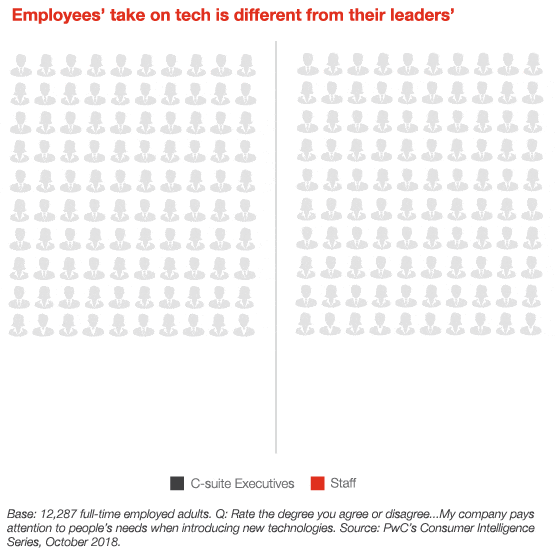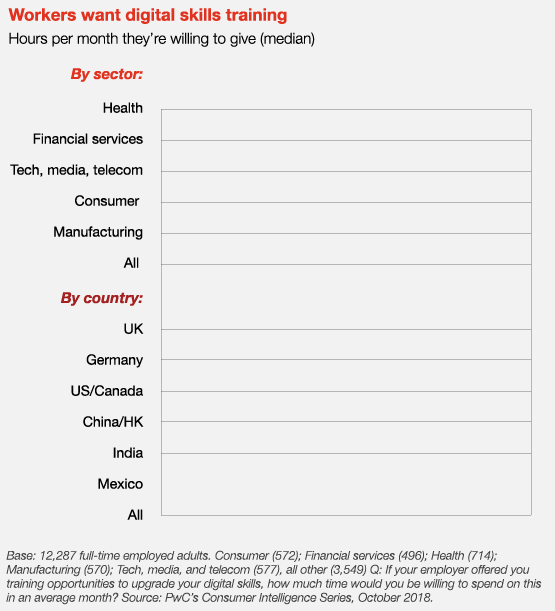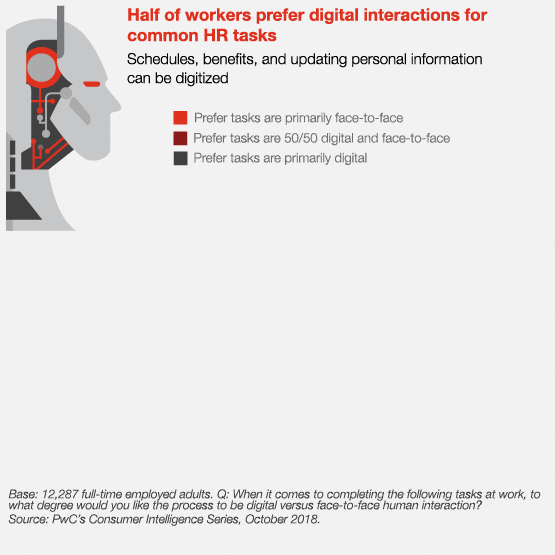Leaders think they’re choosing tech to get great work from employees—yet our global survey of more than 12,000 workers shows a disconnect, in which leaders and staff see things differently. When it comes to the digital tools people use in their day-to-day jobs, that relationship status is best described as “it’s complicated.”
We know from a decade of research on the value of digital investments that companies are not so much falling behind as struggling to move faster with what’s next. Understanding how experiences and attitudes shape workers’ willingness to adopt tech at work can go a long way in helping you build great performance.
Why putting people at the heart of your tech solutions creates a more motivated, energetic and productive workforce.
What people say about tech at work
We asked 12,000 people from Canada, China and Hong Kong SAR, Germany, India, Mexico, the UK and the US to share their views about the digital tools they use in their daily work. We heard from all generations, from C-suite titles to administrative roles, and from a range of industries including consumer markets, health industries, financial services, manufacturing and technology and media. Here’s what we learned.
Five must-knows
Leaders say they’re choosing tech with their people in mind, but employees don’t agree
People want digital skills. How can desire turn into results?
People value the human touch at work, but they also like a digital assist
Efficiency and status drive interest in advancing digital skills
Leaders say they’re choosing tech with their people in mind, but employees don’t agree
90% of C-suite executives believe their company pays attention to people’s needs when introducing new technology, but only about half (53%) of staff say the same. Sure, you have your own tech annoyances—65% of C-suite executives say they’re often frustrated by technology at work. But when tools don’t function the way the boss thinks they should, there’s usually someone to delegate the problem to. Your people, however, have no choice but to muddle through. While 92% of C-suite execs say they’re satisfied with the technology experience their company provides for making progress on their most important work, only 68% of staff agree.
That experience gap matters. When you don’t have a clear and accurate understanding of how your people use technology in their jobs, and what they need and want from those tools, their overall experience at work can suffer. A subpar employee experience can have a ripple effect across the organization, shaping everything from how engaged people are to their enthusiasm for delivering a superior customer experience.
So what do your employees really want from the tech they use on the job? From choosing devices, to picking apps, to opting for voice over text, employees look for options that help them do their best work. For example, changing work environments mean more people want greater mobile capabilities, but only 60% of employees say they’re satisfied with the mobile options available to them at work. Others want to gain a stronger sense of control by having more input before leaders choose the systems they will use regularly.

73% of people surveyed say they know of systems that would help them produce higher quality work.

People want digital skills. How can desire turn into results?
Today’s workforce is curious about technology, and ready to invest time in learning. Employees report that they’re willing to spend up to two days per month on training to upgrade their digital skills, if offered by their employer—a median response of 15 hours each month. This is not to say you need to take people out of the workday, but it does give insight into what people say they’re willing to do. At the same time, the shelf-life for skills is rapidly getting shorter as tech evolves. Employees who want to keep up need to adopt a continual-learning mind-set, and it’s up to leaders to help them find ways to integrate skill development into their jobs. The World Economic Forum estimates that by 2022, more than half (54%) of employees are going to need significant training, with more than a third of that number (35%) needing at least six months’ worth of effort.
Even when people want to develop their skills, many feel there aren’t enough ways to do it through their workplace. Only 50% of staff and 64% of managers are satisfied with the resources they have at their disposal to learn how to use new technology, signaling an opportunity for leaders to open new pathways for learning and development. And those who are working on their skills say employers don’t acknowledge that effort: 46% say their company doesn’t value employees who are technologically savvy.
Employees value the human touch at work...
People don’t want interactions with machines to fully replace the valuable human connections they need to have a genuine sense of belonging at work and to provide customers with what they feel is missing—a human touch. 40 to 45% of employees prefer face-to-face interactions for tasks like performance reviews, getting help with difficult problems and asking questions of their Human Resources (HR) team.
About the same number of people prefer many of these same tasks to be partially or fully digitized—a signal that digital assistance does have a place when it’s seamless and unobtrusive, or where it can enhance people’s work experience. For example, while most employees prefer face-to-face interactions for performance reviews, they also like the immediate and continual validation they can receive through digital means (think social media “likes” and comments).
Finding the balance between bots and humans means business leaders have to ask important questions about technology choices. To what extent will technology choices lead to the isolation of your employees from one another? Is automation limiting the time people have for thinking or creating together? More than half of employees think that could be true now—56% say they feel technology is taking them away from human interaction at work.


...but they also like a digital assist
There is an exception, of course. Your employees are happy to have certain tasks digitized—if it can free them up to do more important and engaging work. That is, after all, one of the big promises of tech and digital. Half of employees prefer that HR tasks, like looking for a new job in the company, scheduling work or time off or enrolling in benefits, be primarily digital and not face-to-face.
In a perfect world, technology would streamline rote tasks for middle managers so they can focus more on interacting with and guiding the people they supervise. In reality, that potential isn’t close to being realized. Supervisors, for example, feel like their time isn’t managed better, but instead is pinched by the workplace technology they’re using. Nearly half of employers in a supervisory role (46%) say they feel overwhelmed by technology at work, while 61% say they spend more time getting technology to work than they’d like. “I enjoy what I’m doing, but it can become a grind when I have a transaction and I have to run through all these programs,” a US sales executive told PwC.
Efficiency and status drive interest in advancing digital skills
Attitudes and behaviors can shape people’s willingness to adopt new technologies, and most people in our survey are motivated by two distinct incentives: improved efficiency and rewards that improve their status. This split holds true for people in all levels of the organization, in every function and team and from every generation.

Knowing what shapes people can help you connect with them. It’s a chance to link communications strategies, rewards and performance and development to better match what drives them.
For a third of the workforce (34%), the motivation to use technology comes from curiosity and the promise of better efficiency and teamwork. This group wants to solve problems and have more efficient ways to do their work and collaborate with their teams. They’re most likely to invest in using technology if and when it helps them accomplish those goals. This group is the most open to having more tasks or processes digitized, and is also willing to invest more time per month in training (20 hours in an average month). Because they value teamwork and collaboration, this group is more likely to champion the value of using new tech to their co-workers.
This split holds true for people in all levels of the organization, in every function and team and from every generation.
Another third (37%) are more likely to adopt new tech if it helps them advance their careers or gain status, such as the opportunity for promotion or other external recognitions. This segment of the workforce is more likely to have more frustrations with technology than other groups and they’re more skeptical about how today’s technology is helping them achieve their goals. They prefer the fewest number of programs and apps to do their work and they say they have too many to use right now. Surprisingly, they don’t believe that their company values people who are technically savvy. And because status drives their interest, they may pass up opportunities for skill building if they can’t see how they’ll be valued for it. Still, they say they’re willing to give 17 hours in an average month on digital skill development. Encourage their interest in using digital tools by showing them how these skills will benefit them and their career progression.
Knowing what shapes people can help you connect with them. It’s a chance to link communications strategies, rewards and performance and development to better match what drives them.
The third segment (29%) prefers individual achievement within a predictable environment. They like to stick with established routines and they’re more likely to say they care about the well-being of their co-workers. That doesn’t mean they aren’t open to new things, but they’re less apt to have strong motivations toward efficiency or status; as such, finding common motivations to encourage this group around tech may be more difficult.
Above all, this segment is the least likely to see the importance of digital skills for their work. Only 47% agree that their employer does a good job communicating about the importance of digital skills for the success of the company. That’s far lower than the 82% of status seekers and 77% of those motivated by curiosity, efficiency and teamwork. Because this segment is more likely to include people who are reluctant to embrace technology, they may need additional communication and training to help bring them up to speed on current technology before they’re introduced to new tech. And they still want to learn. They’re willing to devote 10 hours in an average month to developing digital skills. Emphasize how using new technology can distinguish them from others and help them link their personal work to your company’s purpose and ways of creating value.
How to get more buy-in from your people
- You can’t separate technology from your people’s experience and what motivates them
- Understand what it’s like to do the job
- Rethink who belongs in the room when making decisions
- Upskilling is not traditional training—change your mind-set
You can’t separate technology from your people’s experience and what motivates them
Technology is now such a central part of the overall work experience that you can’t separate it from the people agenda. To manage both, look to the promise of new technology and consider what motivates people to adopt new ways of working with tech. It can’t be one or the other. The goal is to get beyond titles and delve into attitudes and behaviors. That’s the approach that leads to more relevant communication, rewards and performance and development. Automation will put even more focus on understanding how to create great places for people to work because it will impact just about everyone’s role, job content and decision rights. Today’s workforce is overwhelmingly positive about the potential for technology to improve their lives in our survey, but they also have concerns about how it can be used. When asked if artificial intelligence is making the world a better place, for example, 88% of the C-suite agreed—but only 48% of staff agreed. Understand why this gap exists between your leaders and your employees and work to alleviate those worries.
Understand what it’s like to do the job
It’s becoming more common to analyze process efficiency with data analytics, but you should also seek to understand what it’s like to do work through the lens of the employee. Start by defining different worker personas for the processes that matter most and get feedback from employees on what it’s like to do the work. Understand an employee’s daily journey, their day-to-day routines and touchpoints so you can help define how technology can support a better work experience, rather than simply create extra overhead. For instance, where are workers most often when they perform a given transaction—are they at home, in the office, at their desks, on the road, on the shop floor or with a customer? How much time should things take? Use those insights to fuel your approach and get continual feedback as your processes evolve.
Rethink who belongs in the room when making decisions
For starters, choose people from a range of levels and departments across the company to play roles in the planning, selection and design of technology tools. Focus groups, feedback mechanisms, employee surveys and other methods of giving people a voice can help leaders make more people-focused tech decisions and fuel employee buy-in and interest in tech at work.
Informal leaders may also serve as a bridge between leaders and those at lower levels of the organization. These employees, who may not hold an official leadership role but who have a ground-level view of the organization’s cultural reality, can offer insight into what front-line employees want and expect from technology at work. Informal leaders can be a powerful force in accelerating the culture and behavior changes that are essential to any successful tech-led transformation. As one managing director of a furniture supply company in Germany told PwC, “We did not consider that cultural change is needed (and) that takes longer than introducing new software.” Your staff's perspective may be very different from yours, helping you to identify and address obstacles to tech adoption.
Upskilling is not traditional training—change your mind-set
In our survey, 84% of people say they do their work because they want to learn new things. But there’s a clear disconnect between the amount of time they’re willing to spend on training, and what will actually be required to keep up in an era in which they are likely to need to retool skills as job requirements change. Address that disconnect by emphasizing the urgency of adopting a continual learning mind-set—why it’s important to the organization as well as to them personally. Then, support your employees through real-time coaching and feedback so they understand where to focus their development, and help them build learning into their job. Upskilling isn’t just about completing courses or adding new tools; it’s also about giving people opportunities to explore new mind-sets, behaviors, relationships and ways of working. The more organizations support their workforce in becoming digitally savvy, the greater the likelihood that decision-makers will stop thinking about how specific technologies will be transformative and instead focus on changing the ways people work.
And, since many employees don’t feel their company offers enough ways to learn, look for more options, especially those that let employees choose a learning style that works for them. That may mean thinking outside the conventional models of training and development and expanding what qualifies as “training,” such as microlearning or ad hoc online courses. Finally, consider incentives for learning beyond paying people to complete training. Among the possibilities: special recognition and additional opportunities that will expose people to new thinking.
Contact us












